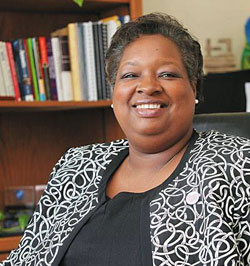 With Tax Day on the horizon, Rae Nwosu wasn’t surprised to get her W-2 tax statement from her Austin, Texas, school district employer. But when she opened it, she got a shock.
With Tax Day on the horizon, Rae Nwosu wasn’t surprised to get her W-2 tax statement from her Austin, Texas, school district employer. But when she opened it, she got a shock.
For a year’s work as a highly ranked school attendance specialist, a job that requires her to collaborate closely with parents, counselors, and administrators to get at-risk students into classrooms where they can be successful, Nwosu earned a total of $19,825.93 last year.
“I was furious when I opened it,” said Nwosu. And it’s not because she doesn’t know what she gets paid. She sees the $1,300 that she takes home in her paycheck each month.
“It wasn’t because of me at all. I was furious because my thought was, “OMG. What if another mom had to live on this salary, and take care of her children on this salary,” said Nwosu, who is married with two grown children, and has worked for the school district for 15 years. “As a union member, I think about my brothers and sisters, and I know they couldn’t make it.”
She’s right about that. Nwosu’s less-than-$20K-a-year salary is not a living wage in Austin, according to a living wage calculator developed by a Massachusetts Institute of Technology (MIT) professor. In fact, the pre-tax wages needed to cover rent, food, and other basic expenses for a single mom with two children in Austin is more than four times higher at $83,805.
“Rae is a professional who works tirelessly advocating for her students’ success,” said Roxanne Dove, director of NEA’s Education Support Professionals (ESP) Quality Department. “We need to recognize and respect all school support staff for their commitment and dedication to students, schools, and their communities.”
Attending to Student Learning
As an attendance specialist, Nwosu’s work isn’t just about pink tardy slips and other paperwork. It’s about student success, and making sure her students are on track to graduate.
Nationally, an estimated 5 to 7.5 million students are chronically absent each year, which is defined as missing at least 10 percent, or 18 days, of the school year. What we know about these students is that they’re much less likely to read on grade level and much more likely to earn lower grades and score worse on standardized tests. By high school, attendance is actually a better predictor than test scores of whether a student will graduate.
"It's common-sense—students have to be in their classrooms to learn, yet too many of our children, and most often our most vulnerable children, are missing almost a month or more of school every year,” said then-U.S. Secretary of Education Arne Duncan in October, as the White House launched its “Every Student, Every Day: A National Initiative to Address and Eliminate Chronic Absenteeism.”
 As an attendance specialist, Rae Nwosu’s work isn’t just about pink tardy slips. It’s about student success, and making sure her students are on track to graduate.
As an attendance specialist, Rae Nwosu’s work isn’t just about pink tardy slips. It’s about student success, and making sure her students are on track to graduate.
But researchers also have found that the negative effects of absenteeism are reversible when adults intervene, when incentives are provided, and when critical programs are put into place.
This is exactly what Nwosu is doing for her middle school, which includes a neighborhood-based academy program that serves kids from three public housing projects. With $25,000 that Nwosu secured through a competitive NEA grant, Nwosu has been able to meet more frequently with academy parents to create attendance plans, and also institute an incentive program for students.
With these efforts, her school’s attendance improved from 95.7 percent this time last year to 97.3 percent this year. “In January, we awarded 13 kids in our academy program with perfect attendance. Last year, we had zero,” she said. Those students received e-readers and Amazon gift cards to buy e-books.
At the end of the school year, the students with the best or most improved attendance also will win an overnight trip to Corpus Christi to visit the aquarium and see other sights. “For a lot of our kids, it’ll be the first time they’ll ever leave the community,” she said. “These incentives work. We’re seeing it in our numbers. And if a student is here, then that student is learning.”
Nwosu’s attendance work also provides the basis for her school’s funding from the state. And attendance isn’t all she does—when she gets to work at 6 a.m. each day, she also arranges for substitute teachers.
The Devaluation of People who Matter
So, this is important work that Nwosu does every day. But you’d get no clue to its critical relationship to student learning if you looked at her paycheck, or at the salaries of so many other education support professionals (ESPs) who work as classroom assistants, special education aides, school bus drivers, cafeteria workers, school secretaries, and more.
In 2011, ESPs working full-time in K12 schools earned an average $28,531, according to the NEA ESP Data Book, published in 2012. These figures ranged from $36,982 in New Jersey to less than $22,000 in South Dakota, Oklahoma, and Mississippi. (The cost of living in Mississippi is lower than New Jersey’s—but not that low. A living wage for a single mother of two in Jackson, Miss., is still $50,549, according to the MIT calculator.)
Nearly one in four ESPs earns less than $15,000 a year.
For Nwosu, this all adds up to a lack of recognition of the important work that ESPs do for students. “We are not valued, as education support professionals, not as much as teachers, which is sad because we are just as important to students and learning. It takes all of us to educate the whole child. “
She continued, “I love working with the kids, and I love what I do, and I know when I walk onto campus at six in the morning that I’m going to make a difference in a kid’s life or a parent’s life. And I know that’s why my ESP brothers and sisters do their jobs, too. But if I were a single mom, or my children were younger, I couldn’t afford to do this job.”







